We’re about to transform your baking routine with these incredibly versatile savory scones that’ll have your kitchen smelling absolutely divine. Unlike their sweet counterparts often enjoyed with afternoon tea these hearty gems pack bold flavors and endless customization possibilities that make them perfect for breakfast brunch or dinner.
What sets our savory scones apart is their tender buttery texture combined with exciting flavor combinations like sharp cheddar and chives or sun-dried tomatoes and herbs. They’re surprisingly simple to master requiring just basic pantry ingredients and minimal hands-on time yet they deliver restaurant-quality results every single time.
Whether you’re hosting a weekend brunch impressing dinner guests or simply craving something more exciting than plain toast these savory scones will quickly become your go-to recipe. We’ve perfected the technique to ensure they rise beautifully and stay incredibly flaky while maintaining that satisfying savory punch that keeps everyone coming back for seconds.
Ingredients
We’ve carefully selected each ingredient to create perfectly tender and flavorful savory scones. Our recipe uses simple pantry staples that combine to deliver bakery-quality results every time.
Dry Ingredients
- 2 cups all-purpose flour
- 1 tablespoon baking powder
- 1 teaspoon salt
- 1/2 teaspoon garlic powder
- 1/4 teaspoon black pepper
- 1/4 teaspoon paprika
- 6 tablespoons cold unsalted butter, cubed
Wet Ingredients
- 3/4 cup cold heavy cream
- 1 large egg
- 2 tablespoons sour cream
- 1 tablespoon Dijon mustard
- 1 egg beaten with 1 tablespoon milk for egg wash
Mix-Ins and Seasonings
- 1 cup sharp cheddar cheese, grated
- 3 tablespoons fresh chives, finely chopped
- 2 tablespoons fresh parsley, minced
- 1/4 cup sun-dried tomatoes, chopped (optional)
- 2 tablespoons bacon bits (optional)
- 1/4 teaspoon dried thyme
- 1/4 teaspoon dried rosemary
Equipment Needed
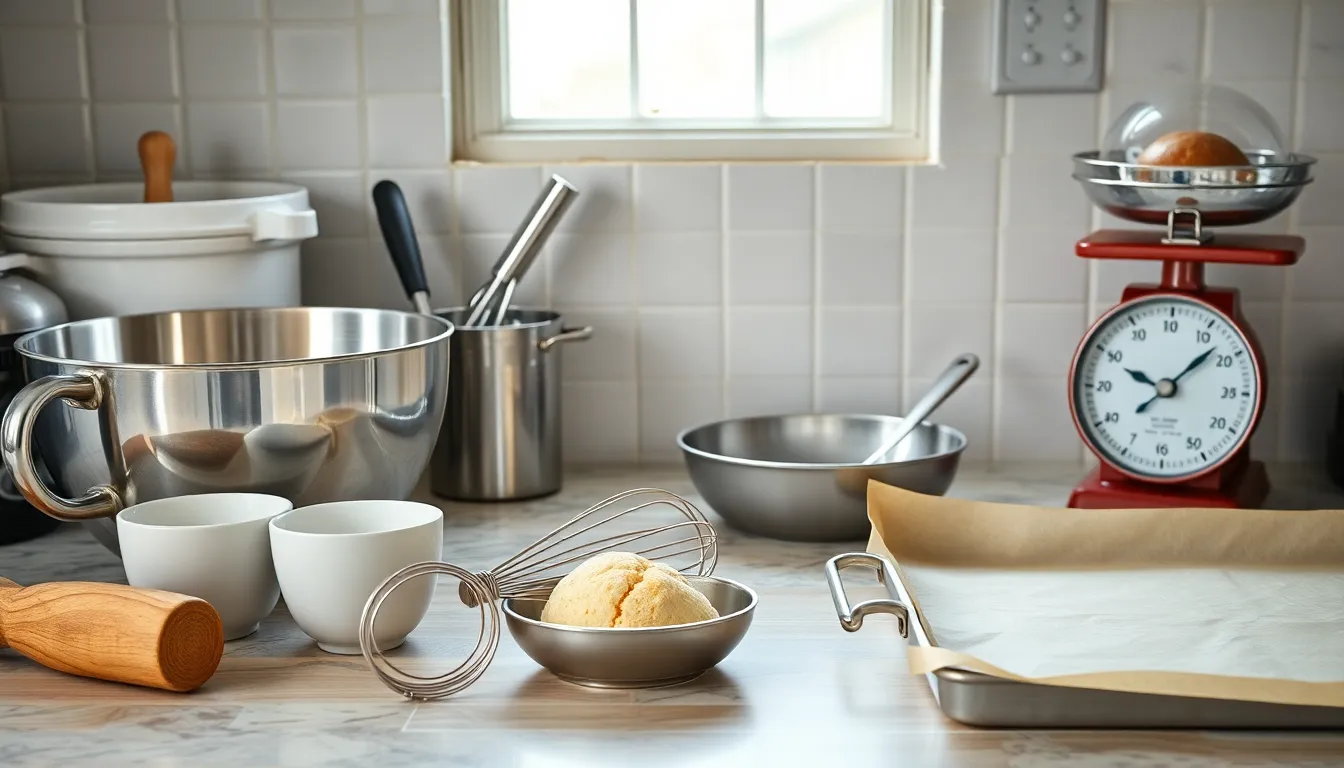
Creating perfect savory scones requires the right tools to achieve that coveted tender, flaky texture we all crave. Our kitchen arsenal doesn’t need to be extensive, but having quality equipment makes the difference between good scones and exceptional ones.
Large mixing bowl serves as our primary workspace for combining dry ingredients and creating the perfect dough consistency. We recommend using a bowl with high sides to prevent flour from scattering during the mixing process.
Pastry blender or food processor becomes essential for incorporating cold butter into our flour mixture. The pastry blender allows us to maintain better control over the texture, while a food processor offers speed and efficiency for larger batches.
Measuring cups and spoons ensure accuracy in our ingredient ratios, which directly impacts the scones’ rise and flavor balance. We prefer using both dry and liquid measuring cups for the most precise results.
Wire whisk helps us properly combine our dry ingredients and create an even distribution of leavening agents throughout the flour mixture.
Baking sheet lined with parchment paper provides the ideal surface for baking our scones without sticking. Parchment paper also promotes even browning and makes cleanup effortless.
Sharp knife or bench scraper allows us to cut clean wedges from our dough circle without dragging or tearing the delicate texture we’ve worked to achieve.
Pastry brush becomes invaluable for applying our egg wash evenly across the scone tops, creating that beautiful golden finish we’re after.
Kitchen scale offers the most accurate measurements for flour and other ingredients, ensuring consistent results every time we bake these savory treats.
Instructions
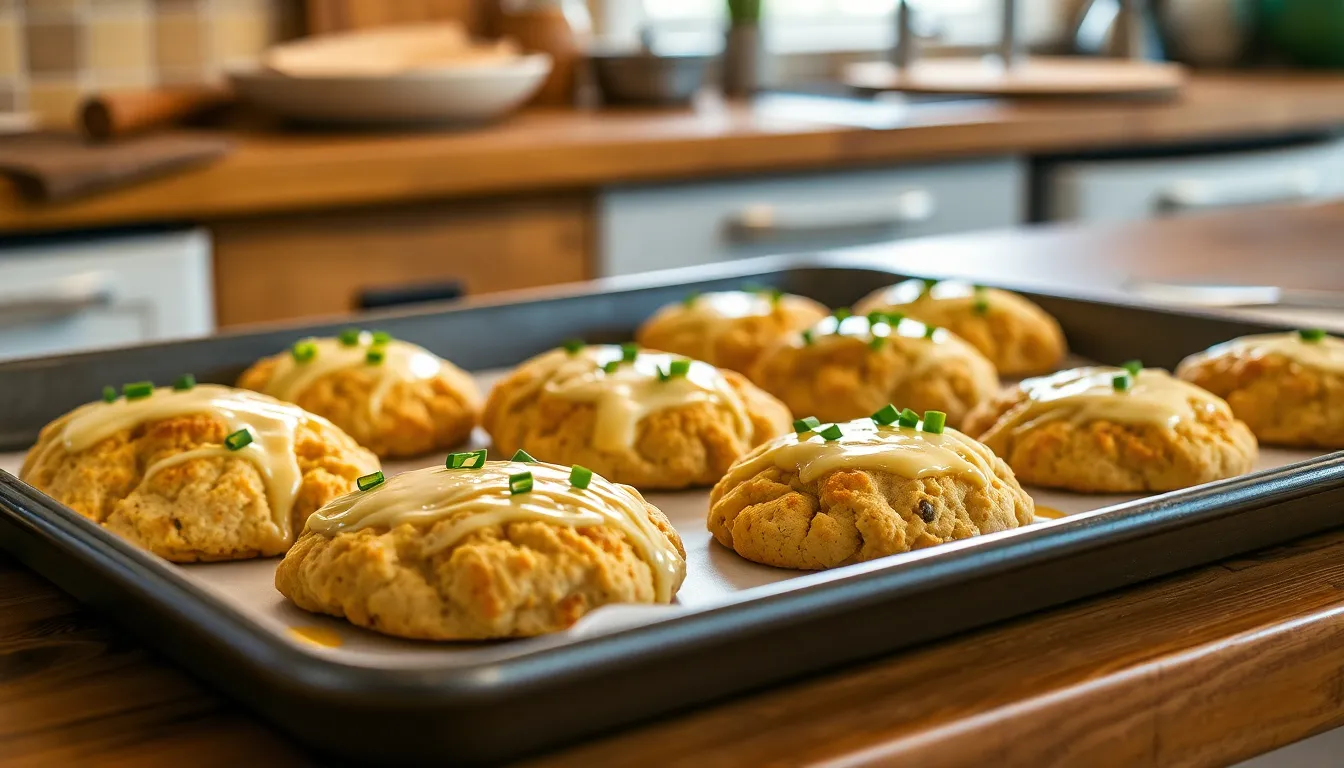
Follow these step-by-step instructions to create perfectly flaky and flavorful savory scones. Each technique builds upon the previous step to ensure restaurant-quality results every time.
Prep the Oven and Pan
Position your oven rack in the center and preheat to 375°F (190°C). Line a large baking sheet with parchment paper to prevent sticking and ensure even browning. The parchment creates a barrier that allows the scones to develop a golden bottom while maintaining their tender interior.
Mix the Dry Ingredients
Whisk together 2 1/4 cups all-purpose flour, 1 teaspoon baking powder, 1/2 teaspoon salt, and 1/2 teaspoon sugar in a large mixing bowl. Distribute the ingredients evenly to ensure proper leavening throughout the dough. The sugar enhances browning and balances the savory flavors without making the scones sweet.
Combine Wet Ingredients
Pour 3/4 cup cold buttermilk into a separate bowl and set aside. Beat one egg in a small dish for the egg wash and reserve for later use. Keep the buttermilk cold to maintain the proper dough consistency and create steam pockets during baking.
Create the Dough
Add 1/2 cup cold grated butter to the flour mixture and work it in until the mixture resembles coarse crumbs with some larger butter pieces visible. Pour the cold buttermilk into the flour mixture and stir gently with a fork until the dough just comes together. Avoid overmixing as this develops gluten and creates tough scones.
Add Mix-Ins
Fold in 1/2 cup grated sharp cheddar cheese and 1/4 cup chopped chives or scallions using gentle motions. Add 2 minced garlic cloves if desired for extra flavor depth. Distribute the mix-ins evenly throughout the dough without overworking it to maintain the tender texture.
Shape the Scones
Turn the dough onto a lightly floured surface and gently pat it into a circle approximately 8 inches in diameter and 3/4 inch thick. Use a sharp knife or bench scraper to cut the circle into 8 equal triangular wedges. Transfer each wedge to the prepared baking sheet, spacing them about 2 inches apart.
Bake the Scones
Brush the tops of each scone with the reserved beaten egg to create a beautiful golden finish. Bake for 18-20 minutes until the tops are golden brown and the scones have risen noticeably. Test for doneness by gently pressing the center of one scone; it should spring back when fully baked. Allow them to cool on the baking sheet for 5 minutes before serving warm.
Directions for Serving

Savory scones taste best when served warm from the oven, allowing their flaky texture and bold flavors to shine through each bite. We recommend letting the scones cool for just 5-10 minutes after baking to avoid burning your tongue while maintaining their optimal temperature and texture.
Pairing savory scones with complementary dishes enhances the overall dining experience significantly. Hearty soups like tomato bisque, butternut squash, or creamy potato leek create perfect combinations that balance the scones’ rich, buttery flavor. Fresh salads with mixed greens, arugula, or spinach provide a crisp contrast that cuts through the scones’ richness beautifully.
Individual serving suggestions vary based on the exact scone variety you’ve prepared. Ham and cheese scones pair wonderfully with a dollop of grainy mustard or cream cheese spread. Parmesan chive versions complement herb butter or a light drizzle of honey for unexpected sweetness. Gruyère, prosciutto, and green onion scones shine alongside fig jam or caramelized onion chutney.
Adding finishing touches right before serving elevates these baked goods from good to exceptional. Sprinkling additional grated cheese over warm scones creates an extra layer of flavor and visual appeal. Fresh herbs like chopped parsley, chives, or thyme add vibrant color and aromatic qualities that enhance each bite.
Storage and reheating methods ensure your savory scones maintain their quality throughout the day. Room temperature storage works well for same-day consumption, while refrigerated scones stay fresh for up to three days. Reheating in a 300°F oven for 5-7 minutes restores their original texture better than microwave warming, which can make them soggy.
Beverage pairings complement savory scones beautifully across different meal times. Morning coffee, afternoon tea, or evening wine all work depending on your exact scone flavors and occasion. Light lagers or crisp white wines enhance cheese-based varieties, while robust red wines pair well with bacon or prosciutto versions.
Storage Instructions
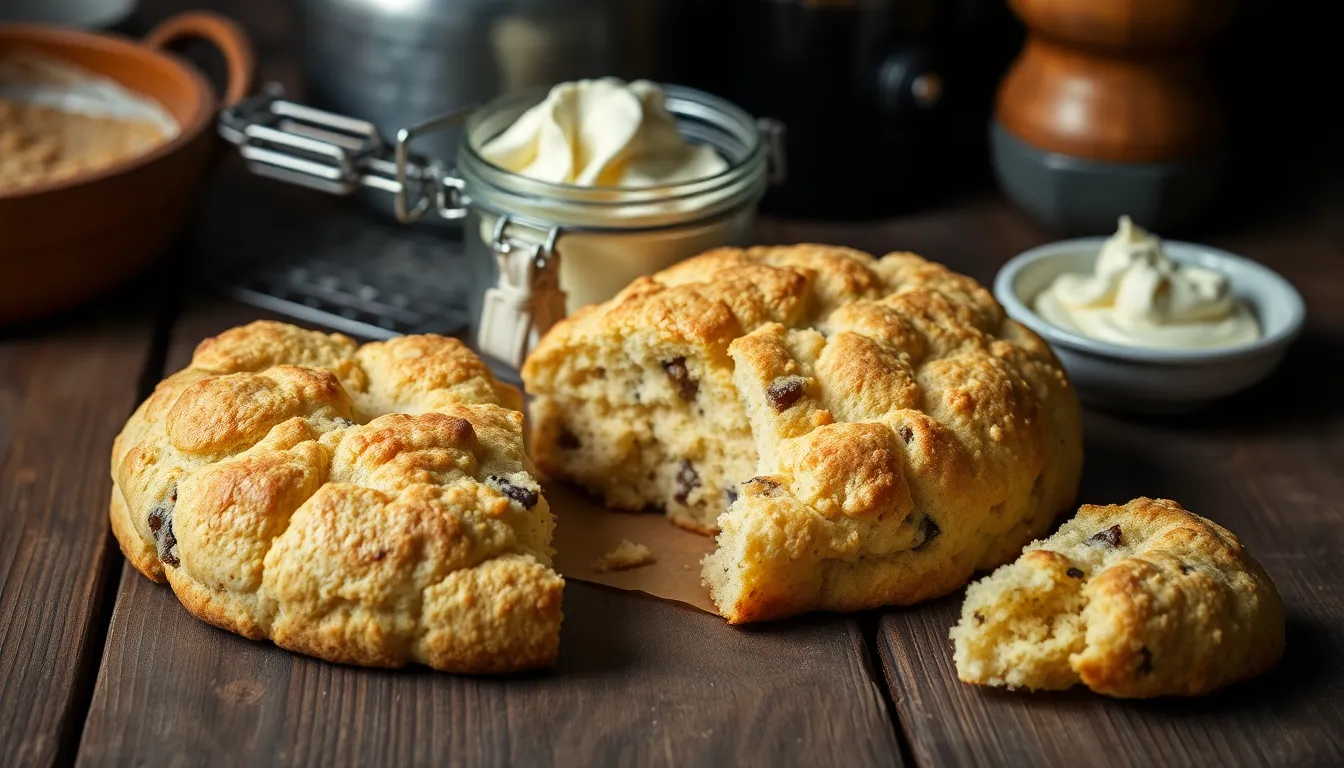
We understand that proper storage is essential for maintaining the quality and freshness of your homemade savory scones. These delectable treats require exact storage methods to preserve their tender texture and bold flavors.
Room Temperature Storage
Fresh savory scones store best at room temperature for immediate consumption. Place your cooled scones in an airtight container or resealable plastic bag to maintain their moisture and prevent them from becoming stale. We recommend consuming room temperature stored scones within 1 to 3 days for optimal flavor and texture. Some varieties may maintain their quality for up to 4 days when stored in a tightly sealed container.
Refrigerator Storage
Extended storage requires refrigeration to prevent spoilage and maintain freshness. Transfer your scones to an airtight container and store them in the refrigerator for up to 5 days. This method works particularly well for scones containing perishable ingredients like cheese or bacon.
Freezing Options
Freezing provides the longest storage solution for both baked and unbaked scones. Baked scones freeze beautifully when placed in an airtight container with parchment paper between layers to prevent sticking. We store frozen baked scones for up to 3 months without compromising quality.
Unbaked scones offer even more convenience through freezing. Arrange shaped scones on a baking tray and freeze until solid before transferring them to a freezer bag. This method allows you to bake fresh scones directly from frozen by simply increasing the baking time as needed.
Reheating Methods
Proper reheating restores the warm, flaky texture that makes savory scones irresistible. Warm your scones in a preheated 300°F (150°C) oven for 5 to 10 minutes until heated through. Alternatively, use a microwave in 20 second increments until the scones reach your desired temperature.
| Storage Method | Duration | Container Requirements |
|---|---|---|
| Room Temperature | 1-4 days | Airtight container or plastic bag |
| Refrigerator | Up to 5 days | Airtight container |
| Freezer (baked) | Up to 3 months | Airtight container with parchment layers |
| Freezer (unbaked) | Indefinite | Freezer bag after tray freezing |
Make-Ahead Tips
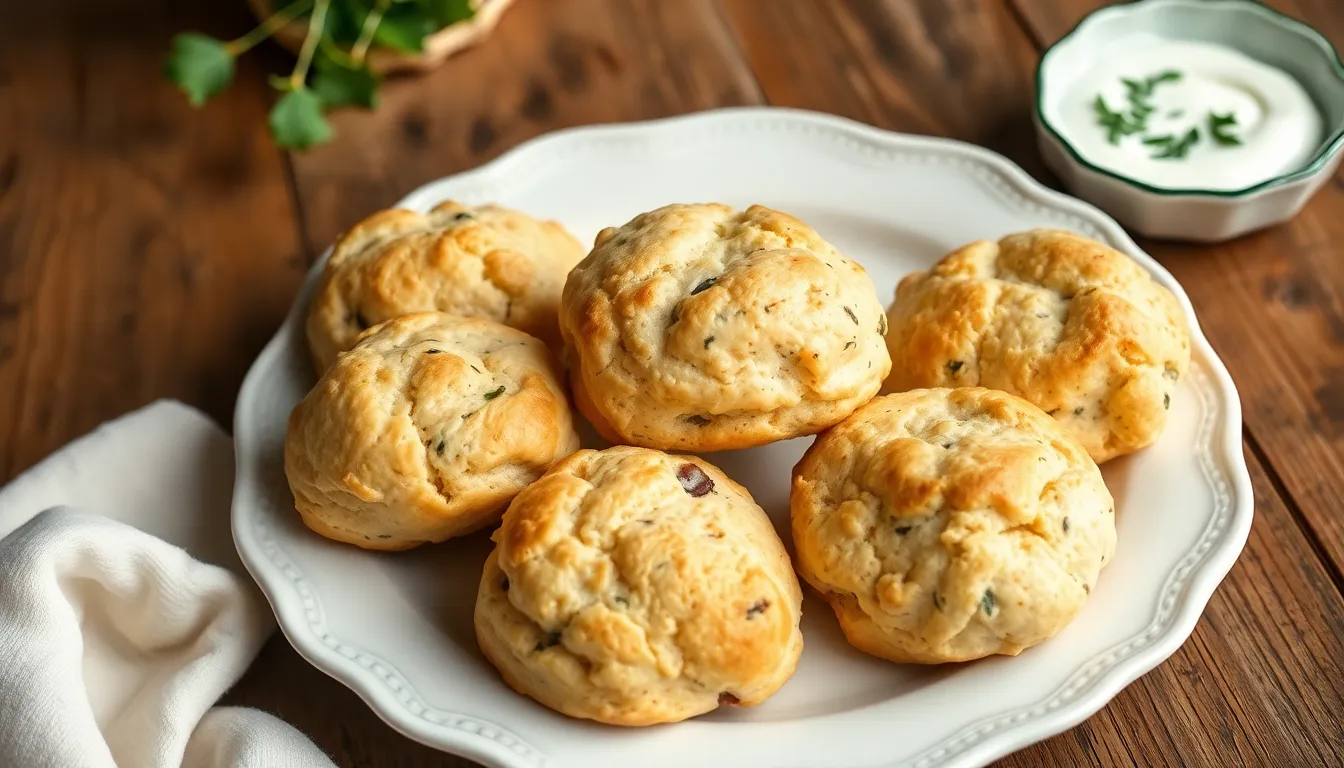
Planning ahead transforms our savory scone baking experience from stressful to seamless. We can prep these delicious treats in several ways that maintain their quality while saving precious time during busy mornings or when entertaining guests.
Refrigerating Shaped Dough
After shaping and cutting our scones, we recommend chilling them in the refrigerator for at least 15 minutes while the oven preheats. This simple step helps maintain their shape during baking and significantly improves the final texture. Cold dough creates better steam pockets, resulting in taller, flakier scones that rise beautifully in the oven.
Freezing for Extended Storage
Freezing offers our most flexible make-ahead option. We can freeze shaped and cut scone dough for 30 minutes before baking to firm up the structure, or store the prepared dough in airtight containers or freezer bags for several weeks.
| Storage Method | Timeline | Benefits |
|---|---|---|
| Quick freeze before baking | 30 minutes | Firmer dough structure |
| Freezer bag storage | Several weeks | Convenient batch prep |
| Long-term freezing | Up to 3 months | Extended meal planning |
Frozen scones bake directly from the freezer without thawing. We simply add a few extra minutes to the standard baking time and achieve the same golden, flaky results as fresh dough.
Prepping Dry Ingredients
Advance preparation extends beyond just the shaped dough. We can combine our dry ingredients and cut in the butter, then store this mixture in the refrigerator for one to two days before finishing the recipe. This technique works perfectly for busy weeknight dinners or weekend brunch preparations.
Wet Ingredient Strategy
We recommend preparing wet ingredients separately by combining eggs and buttermilk or heavy cream just before adding them to the dry mixture. This prevents overmixing and maintains the tender texture we want in our finished scones.
Final Touches
Before baking, we brush our chilled scones with half and half or cream to achieve that coveted golden, crisp top. Fresh scones deliver the best flavor and texture when baked just before serving, though leftover scones reheat beautifully in the microwave or oven for later enjoyment.
Variations and Substitutions
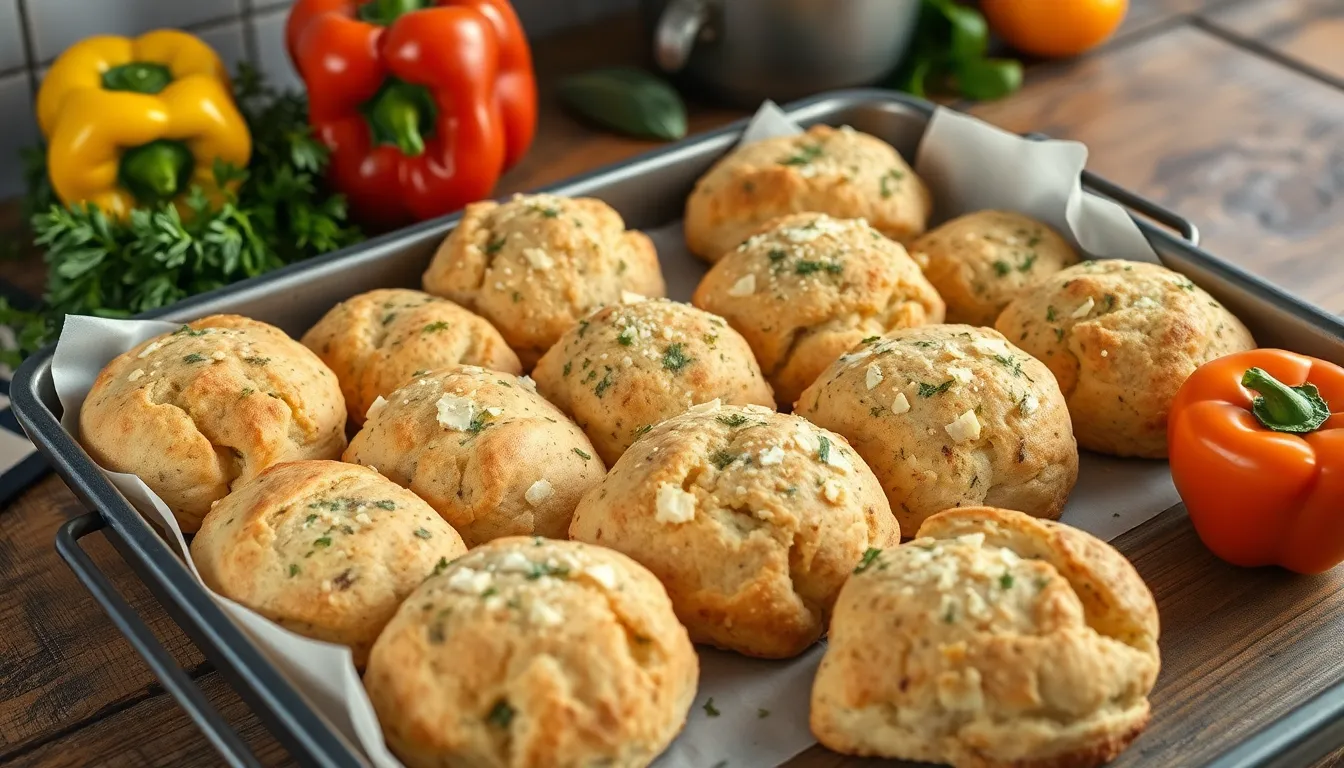
Transform our basic savory scone recipe into countless flavor combinations with these simple ingredient swaps and additions. Each variation maintains the same tender, flaky texture while delivering unique taste profiles to suit any preference.
Cheese and Herb Variations
We recommend experimenting with different cheese varieties to create distinctive flavor profiles in your scones. Sharp cheddar delivers a bold, tangy bite that pairs beautifully with fresh chives, while creamy Gouda offers a mild, nutty sweetness that complements earthy herbs like thyme or rosemary. Monterey Jack provides a smooth, buttery flavor that works well with spicy jalapeños or bell peppers.
Feta cheese creates a Mediterranean twist with its salty, crumbly texture that pairs perfectly with fresh dill and sun-dried tomatoes. Parmesan brings an intense, nutty flavor that elevates scones when combined with fresh basil or oregano. Fresh herbs deliver the most vibrant flavors, but dried herbs work well when fresh options aren’t available—simply use one-third the amount of dried herbs compared to fresh.
Consider these winning combinations for your next batch: extra-sharp cheddar with fresh chives, Gouda with rosemary and cracked black pepper, or feta with dill and lemon zest. Each cheese variety brings its own melting properties and flavor intensity, allowing you to customize the scones to your taste preferences.
Vegetable Add-Ins
Incorporating vegetables into our savory scones adds texture, flavor, and nutritional value to each bite. Diced bell peppers provide a sweet crunch and vibrant color, while finely chopped onions contribute a savory depth that complements any cheese variety. Sun-dried tomatoes offer concentrated umami flavor and chewy texture that pairs exceptionally well with Italian herbs and Parmesan cheese.
Sautéed mushrooms bring an earthy richness that works beautifully with Gruyère cheese and fresh thyme. Roasted red peppers add smoky sweetness and brilliant color, while jalapeños deliver a spicy kick that balances rich cheeses. Fresh spinach or kale can be wilted and chopped finely to add nutritional value without overwhelming the scone’s texture.
Pre-cooked vegetables work best in scone dough since raw vegetables can release moisture during baking and affect the final texture. Drain any excess liquid from vegetables before incorporating them into the dough, and aim for about 1/2 cup of add-ins per batch to maintain the proper dough consistency.
Gluten-Free Options
Creating gluten-free savory scones requires careful ingredient substitutions to maintain the desired texture and rise. Replace all-purpose flour with a high-quality gluten-free flour blend that contains xanthan gum, which helps bind the ingredients and create structure. Almond flour works well for a nutty flavor profile, though it creates a denser texture than traditional wheat flour.
We’ve found that gluten-free scones benefit from an extra tablespoon of liquid to compensate for the different absorption properties of alternative flours. Cold butter remains crucial for creating flaky layers, so maintain the same temperature requirements as the original recipe. Allow the dough to rest for 10 minutes after mixing to help the gluten-free flour hydrate properly.
Verify that all other ingredients are gluten-free, including baking powder, seasonings, and any add-ins like bacon or cheese. Some processed meats and flavored cheeses may contain gluten-containing ingredients, so always check labels carefully. The baking time may need slight adjustment, so watch for the same golden-brown color and firm texture as indicators of doneness.
Troubleshooting Tips
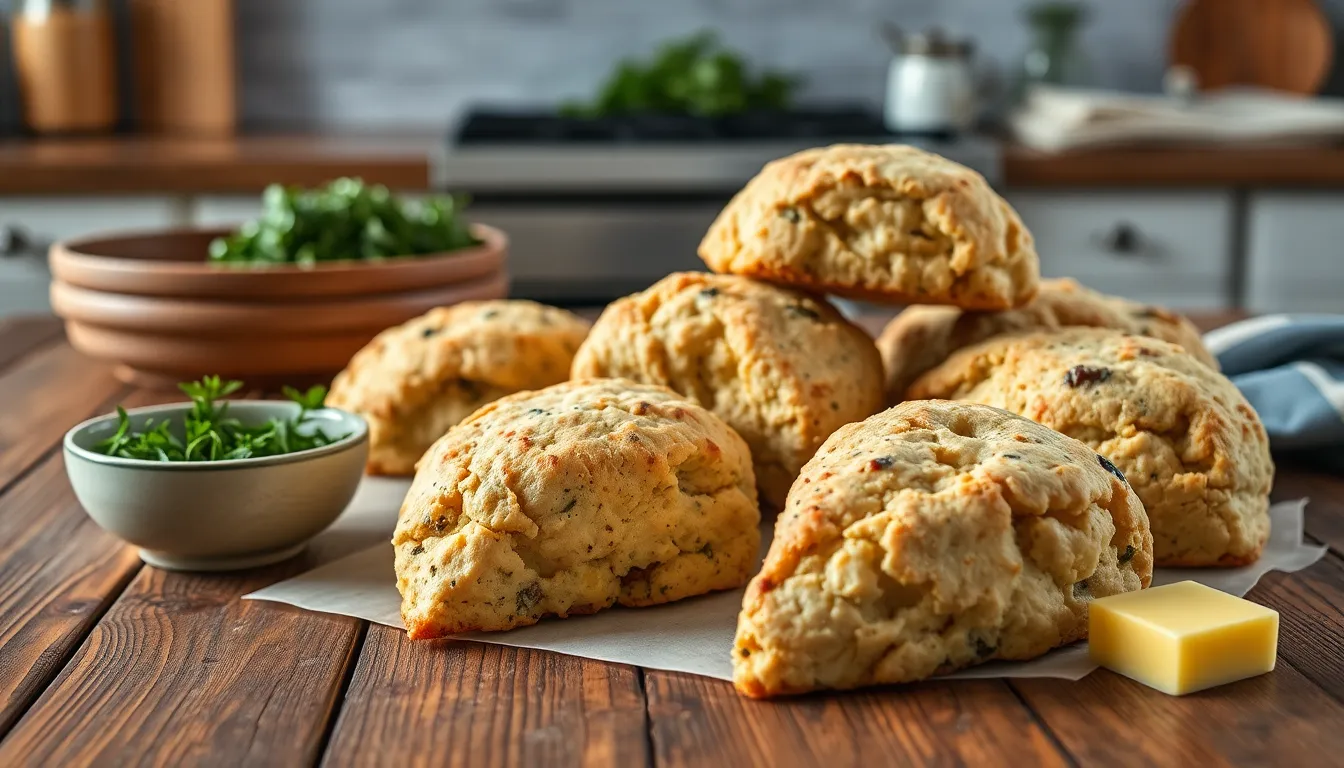
Making perfect savory scones requires attention to detail and understanding common pitfalls that can affect your results. We’ve identified the most frequent issues home bakers encounter and provide answers to ensure your scones turn out flaky and delicious every time.
Overmixing Creates Tough Scones
The most critical mistake involves overworking the dough during mixing. We recommend stopping as soon as the ingredients come together with a few streaks of flour still visible. Gentle folding motions work better than vigorous stirring to maintain the tender texture we want in our finished scones.
Insufficient Rising Indicates Baking Powder Problems
Fresh baking powder serves as the foundation for properly risen scones. We suggest testing your baking powder by mixing a teaspoon with hot water to check for immediate fizzing. Old or expired leavening agents will produce flat and dense results rather than the light and airy texture we expect.
Hard Scones Result From Multiple Factors
Several factors contribute to tough scones that lack the desired flakiness. Overworking the dough ranks as the primary culprit followed by insufficient liquid content. Using old baking powder also creates hardness by preventing proper rise during baking.
Dry Dough Requires Careful Liquid Adjustment
We encounter dry dough when the flour absorbs more moisture than expected or when measuring inaccuracies occur. Adding liquid one tablespoon at a time prevents overhydration while ensuring the dough holds together properly. Cold ingredients maintain the butter in solid pieces which creates the flaky layers we desire.
Temperature Control Prevents Common Issues
Maintaining cold ingredients throughout the process ensures success with savory scones. We keep butter cold by grating it directly from the refrigerator and using chilled cream or buttermilk. Room temperature ingredients can cause the butter to melt prematurely and eliminate the flaky texture that makes scones special.
Conclusion
We’ve shared everything you need to master the art of savory scone baking. These versatile treats offer endless possibilities for customization and can transform your everyday meals into something special.
With our tested techniques and troubleshooting tips you’ll create bakery-quality scones that are perfectly flaky every time. The make-ahead options and storage methods we’ve outlined ensure you can enjoy fresh scones whenever cravings strike.
Start experimenting with different flavor combinations and discover your personal favorites. These savory scones will quickly become a staple in your kitchen repertoire.
Frequently Asked Questions
What makes savory scones different from sweet scones?
Savory scones incorporate bold flavors like cheese, herbs, and spices instead of sugar and sweet ingredients. They feature combinations such as sharp cheddar with chives or sun-dried tomatoes with herbs, making them perfect for breakfast, brunch, or dinner rather than just dessert.
How long do savory scones stay fresh?
Fresh savory scones can be stored at room temperature in an airtight container for 1-4 days. For longer storage, refrigerate for up to 5 days, especially if they contain perishable ingredients like cheese. Frozen baked scones maintain quality for up to 3 months.
Can I make savory scones ahead of time?
Yes! You can refrigerate shaped dough for at least 15 minutes before baking to improve texture. Alternatively, freeze unbaked scones for extended storage and bake directly from frozen. You can also prep dry ingredients in advance and combine wet ingredients just before mixing.
What’s the best way to reheat leftover savory scones?
Reheat savory scones in a preheated 350°F oven for 5-8 minutes to restore their flaky texture and warmth. You can also use a microwave for 15-20 seconds, though the oven method provides better texture results.
Can I substitute ingredients in savory scone recipes?
Absolutely! Experiment with different cheeses like Gouda or feta, add vegetables such as bell peppers or sun-dried tomatoes, and try various herbs. For gluten-free options, use high-quality gluten-free flour blends with slight liquid adjustments to maintain proper texture.
Why are my savory scones tough instead of flaky?
Tough scones usually result from overmixing the dough or using warm ingredients. Keep butter and cream cold, mix just until ingredients come together, and avoid overworking the dough. Using fresh baking powder and maintaining proper ingredient temperatures ensures flaky, tender scones.
What equipment do I need to make perfect savory scones?
Essential tools include a large mixing bowl, pastry blender or food processor, measuring cups and spoons, wire whisk, parchment-lined baking sheet, sharp knife or bench scraper, pastry brush for egg wash, and optionally a kitchen scale for precise measurements.













